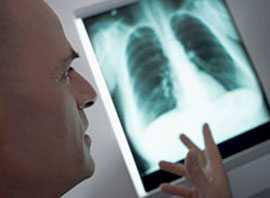Clinical Features
On This Page
The major clinical syndromes of pneumococcal disease are pneumonia, bacteremia, and meningitis. Researchers do not clearly understand the immunologic mechanism that allows disease to occur in a carrier. However, disease most often occurs when a predisposing condition exists, particularly pulmonary disease, and, if it is going to occur at all, shortly after colonization.
Pneumonia

Pneumococcal pneumonia is the most common clinical presentation of pneumococcal disease among adults. Pneumonia without bacteremia or empyema is not considered to be “invasive” disease. The incubation period of pneumococcal pneumonia is short, about 1 to 3 days. Symptoms generally include an abrupt onset of fever and chills or rigors. Typically, there is a single rigor, and repeated shaking chills are uncommon. Other common symptoms include
- Pleuritic chest pain
- Cough productive of mucopurulent
- Rusty sputum
- Dyspnea
- Tachypnea or tachycardia
- Hypoxia
- Malaise or weakness
Nausea, vomiting, and headaches occur less frequently.
CDC estimates that as many as 400,000 hospitalizations from pneumococcal pneumonia occur annually in the United States. Pneumococci account for up to 30% of adult community-acquired pneumonia. Bacteremia occurs in up to 25–30% of patients with pneumococcal pneumonia. The case-fatality rate is 5–7% and may be much higher among elderly persons. Complications of pneumococcal pneumonia include empyema, pericarditis, and respiratory failure.
Bacteremia
An estimated 5,000 cases of pneumococcal bacteremia (without pneumonia) occur each year. The overall case-fatality rate for bacteremia is about 20% but may be as high as 60% among elderly patients. Patients with asplenia who develop bacteremia may experience a fulminant clinical course.
Bacteremia without a known site of infection is the most common invasive clinical presentation of pneumococcal infection among children 2 years old or younger, accounting for approximately 70% of invasive disease in this age group. Bacteremic pneumonia accounts for about 12–16% of invasive pneumococcal disease among children 2 years old or younger.
Meningitis
Pneumococci cause over 50% of all cases of bacterial meningitis in the United States. An estimated 2,000 cases of pneumococcal meningitis occur each year. Some patients with pneumococcal meningitis also have pneumonia. The clinical symptoms, cerebrospinal fluid (CSF) profile, and neurologic complications are similar to other forms of purulent bacterial meningitis. Symptoms may include
- Headache
- Lethargy
- Vomiting
- Irritability
- Fever
- Nuchal rigidity, cranial nerve signs, or seizures
- Coma
The case-fatality rate of pneumococcal meningitis is about 8% among children and 22% among adults. Neurologic sequelae are common among survivors. Persons with a cochlear implant appear to be at increased risk of pneumococcal meningitis.
With the decline of invasive Haemophlius influenzae type b disease, S. pneumoniae has become the leading cause of bacterial meningitis among children younger than 5 years old in the United States. Before routine use of pneumococcal conjugate vaccine, children younger than 1 year old had the highest rates of pneumococcal meningitis, approximately 10 cases per 100,000 population.
Acute Otitis Media
Pneumococci are a common cause of acute otitis media, causing up to 20% of those infections. By age 12 months, more than 60% of children have had at least one episode of acute otitis media. Middle ear infections are the most frequent reasons for pediatric medical visits in the United States, resulting in more than 18 million visits annually, and the most common reason that children receive antibiotics. Complications of pneumococcal otitis media may include mastoiditis and meningitis.
Related Link
-
Pink Book’s Chapter on Pneumococcal Disease
Epidemiology and Prevention of Vaccine-Preventable Diseases textbook
- Page last reviewed: September 6, 2017
- Page last updated: September 6, 2017
- Content source:


 ShareCompartir
ShareCompartir